#Theodore Roosevelt National Park (South Unit)
Explore tagged Tumblr posts
Text
Nina Golgowski at HuffPost:
A Republican lawmaker has introduced a bill that would add President Donald Trump’s face to Mount Rushmore. “Let’s get carving!” Florida Rep. Anna Paulina Luna posted on X Tuesday after introducing legislation she said would recognize what she called Trump’s “remarkable accomplishments” and “the success he will continue to deliver.” “President Trump’s bold leadership and steadfast dedication to America’s greatness have cemented his place in history,” Luna wrote in a statement. “He will be forever remembered among the great like Presidents George Washington, Thomas Jefferson, Abraham Lincoln, and Theodore Roosevelt.” These four presidents were selected to have their likeness carved into the South Dakota granite by artist Gutzon Borglum because, in his view, they represented “the most important events in the history of the United States,” according to the National Park Service, which also acknowledges that the project disregarded the site’s cultural significance for local tribes. There were plans to add the men’s torsos but funds dried up before the work could be completed in 1941. Trump has publicly mused about having his face added to the contested national memorial, telling a crowd in 2017: “I’d ask whether or not you think I will someday be on Mount Rushmore.”
Trump belongs in a jail cell, not on Mount Rushmore or in office.
21 notes
·
View notes
Text
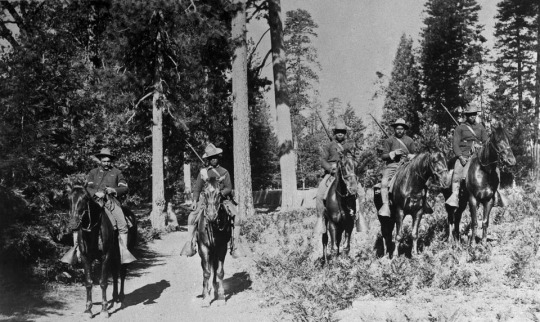
The mighty Buffalo Soldiers !!
Bob Marley wrote a song about them :)
Their accomplishments:
* Created an arboretum along the South Fork of the Merced River in Yosemite near today's Wawona. Widely considered the first marked nature trail and museum in a national park. (1904)
* Constructed the first usable wagon road into the Giant Forest of Sequoia National Park. Some of the oldest, largest trees on the planet. (1903)
* Cut a trail up rugged Mt. Whitney; at 14,505 feet, the tallest peak in the contiguous United States. (1903)
* Served as official escort from San Francisco to Yosemite for President Theodore Roosevelt's historic visit. The 9th Cavalry had the honors, led by Captain Charles Young. (1903)
#public parks#buffalo soldier#legacy#accomplishments#black men#green space#hiking trails#national park
43 notes
·
View notes
Text
1. Acadia National Park, Maine
2. American Samoa National Park, American Samoa
3. Arches National Park, Utah
4. Badlands National Park, South Dakota
5. Big Bend National Park, Texas
6. Biscayne National Park, Florida
7. Black Canyon of the Gunnison National Park, Colorado
8. Bryce Canyon National Park, Utah
9. Canyonlands National Park, Utah
10. Capitol Reef National Park, Utah
11. Carlsbad Caverns National Park, New Mexico
12. Channel Islands National Park, California
13. Congaree National Park, South Carolina
14. Crater Lake National Park, Oregon
15. Cuyahoga Valley National Park, Ohio
16. Death Valley National Park, California & Nevada
17. Denali National Park, Alaska
18. Dry Tortugas National Park, Florida
19. Everglades National Park, Florida
20. Gates of the Arctic National Park, Alaska
21. Gateway Arch National Park, Missouri
22. Glacier Bay National Park, Alaska
23. Glacier National Park, Montana
24. Grand Canyon National Park, Arizona
25. Grand Teton National Park, Wyoming
26. Great Basin National Park, Nevada
27. Great Sand Dunes National Park, Colorado
28. Great Smoky Mountains National Park, Tennessee & North Carolina
29. Guadalupe Mountains National Park, Texas
30. Haleakalā National Park, Hawaii
31. Hawai’i Volcanoes National Park, Hawaii
32. Hot Springs National Park, Arkansas
33. Indiana Dunes National Park, Indiana
34. Isle Royale National Park, Michigan
35. Joshua Tree National Park, California
36. Katmai National Park, Alaska
37. Kenai Fjords National Park, Alaska
38. Kings Canyon National Park, California
39. Kobuk Valley National Park, Alaska
40. Lake Clark National Park, Alaska
41. Lassen Volcanic National Park, California
42. Mammoth Cave National Park, Kentucky
43. Mesa Verde National Park, Colorado
44. Mount Rainier National Park, Washington
45. New River Gorge National Park and Preserve, West Virginia
46. North Cascades National Park, Washington
47. Olympic National Park, Washington
48. Petrified Forest National Park, Arizona
49. Pinnacles National Park, California
50. Redwood National Park, California
51. Rocky Mountain National Park, Colorado
52. Saguaro National Park, Arizona
53. Sequoia National Park, California
54. Shenandoah National Park, Virginia
55. Theodore Roosevelt National Park, North Dakota
56. Virgin Islands National Park, United States Virgin Islands
57. Voyageurs National Park, Minnesota
58. White Sands National Park, New Mexico
59. Wind Cave National Park, South Dakota
60. Wrangell—St. Elias National Park, Alaska
61. Yellowstone National Park, Wyoming, Montana & Idaho
62. Yosemite National Park, California
63. Zion National Park, Utah
9 notes
·
View notes
Text
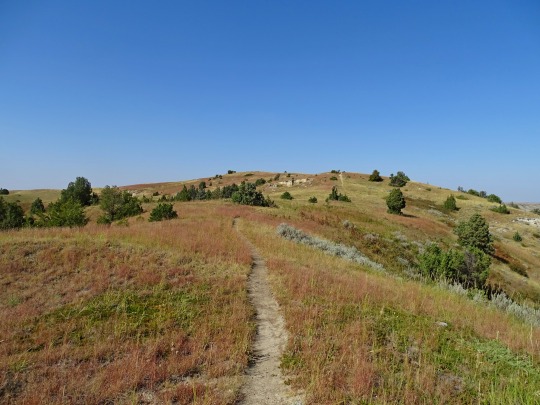
Theodore Roosevelt National Park, North Dakota
Explore:
#north dakota#theodore roosevelt national park#travel#national park#national park service#optoutside#original photography#photographers on tumblr#photography#landscape#nature#nature photography#landscape photography#lensblr#hiking#wanderingjana
15 notes
·
View notes
Photo

Painted Canyon: Theodore Roosevelt National Park South Unit, North Dakota USA (OC) [6000x4000]
8 notes
·
View notes
Text
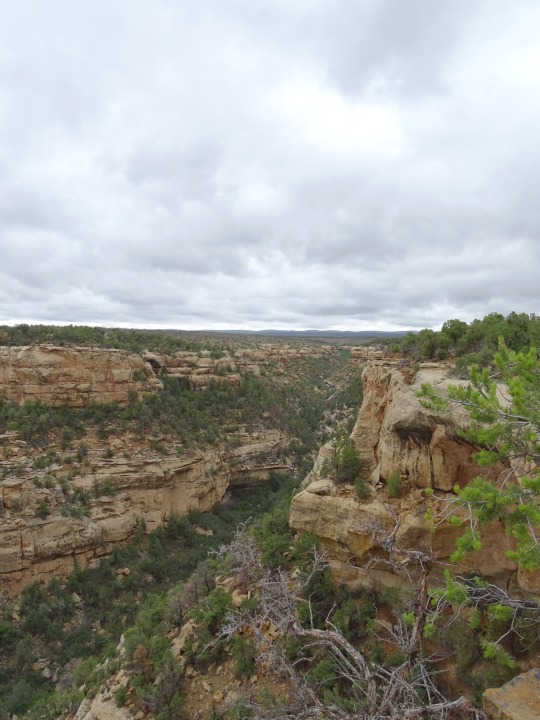
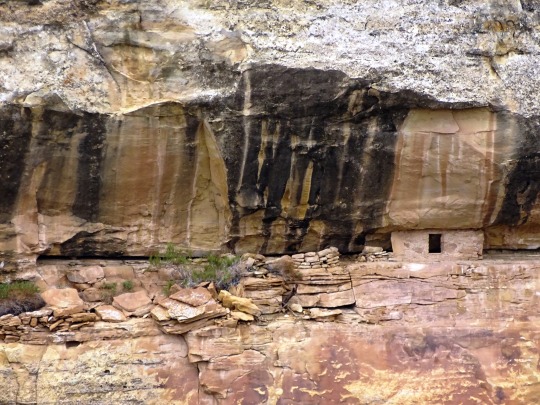

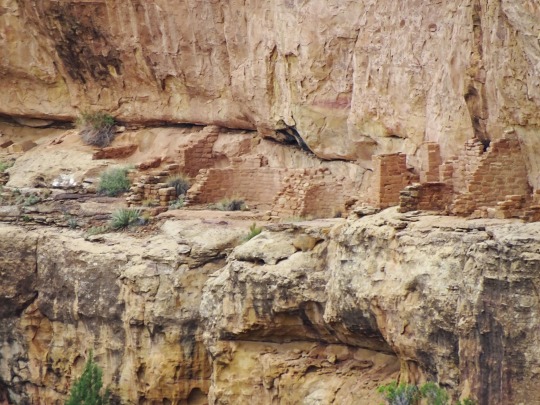
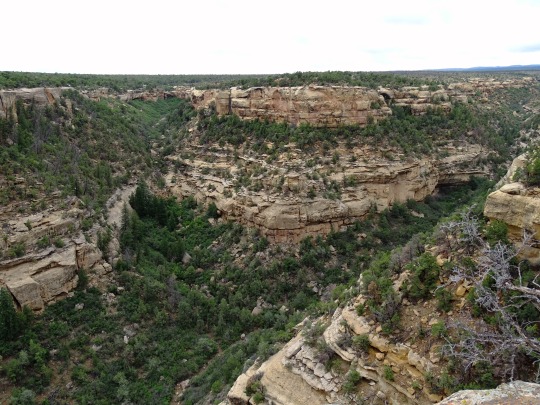
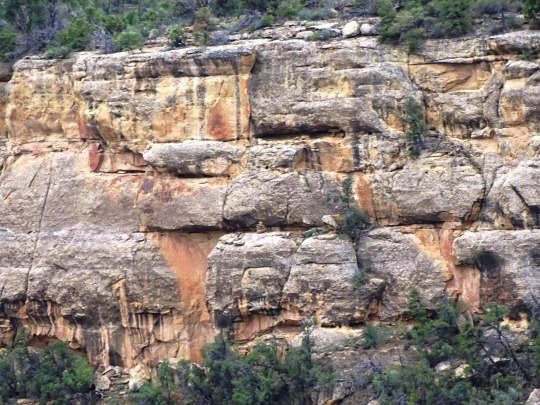



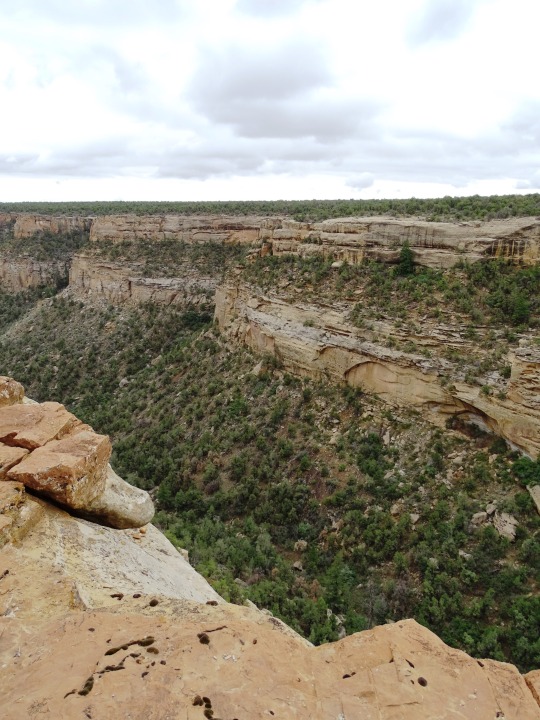
Mesa Verde National Park (No. 1)
Mesa Verde National Park is an American national park and UNESCO World Heritage Site located in Montezuma County, Colorado. The park protects some of the best-preserved Ancestral Puebloan archaeological sites in the United States.
Established by Congress and President Theodore Roosevelt in 1906, the park occupies 52,485 acres (21,240 ha) near the Four Corners region of the American Southwest. With more than 5,000 sites, including 600 cliff dwellings, it is the largest archaeological preserve in the United States. Mesa Verde (Spanish for "green table", or more specifically "green table mountain") is best known for structures such as Cliff Palace, thought to be the largest cliff dwelling in North America.
Starting c. 7500 BC Mesa Verde was seasonally inhabited by a group of nomadic Paleo-Indians known as the Foothills Mountain Complex. The variety of projectile points found in the region indicates they were influenced by surrounding areas, including the Great Basin, the San Juan Basin, and the Rio Grande Valley. Later, Archaic people established semi-permanent rock shelters in and around the mesa. By 1000 BC, the Basketmaker culture emerged from the local Archaic population, and by 750 AD the Ancestral Puebloans had developed from the Basketmaker culture.
The Pueblonians survived using a combination of hunting, gathering, and subsistence farming of crops such as corn, beans, and squash (the "Three Sisters"). They built the mesa's first pueblos sometime after 650, and by the end of the 12th century, they began to construct the massive cliff dwellings for which the park is best known. By 1285, following a period of social and environmental instability driven by a series of severe and prolonged droughts, they abandoned the area and moved south to locations in Arizona and New Mexico, including the Rio Chama, the Albuquerque Basin, the Pajarito Plateau, and the foot of the Sangre de Cristo Mountains.
Source: Wikipedia
#desert varnish#nature#travel#original photography#vacation#tourist attraction#landmark#landscape#countryside#clouds#flora#ancestral puebloan archaeological site#Native American history#summer 2022#Colorado#Mountain West Region#cliff#bush#geology#Mesa Verde National Park#UNESCO World Heritage Site#Montezuma County#Foothills Mountain Complex#ruins#Paleo-Americans
4 notes
·
View notes
Text
A Guide to Historical Landmarks in the USA
For cheap and best Travel Bookings - https://tripsdeals.com/
The United States is home to a rich tapestry of historical landmarks that offer a glimpse into the nation’s past and cultural heritage. From ancient sites to iconic monuments, these destinations serve as a testament to the diverse history that has shaped the country. Whether you’re a history enthusiast or a casual traveler, these landmarks are worth exploring.
1. The Statue of Liberty, New York A symbol of freedom and democracy, the Statue of Liberty welcomes visitors from around the world. Gifted by France in 1886, it stands tall on Liberty Island, offering breathtaking views of the New York City skyline. Guided tours and ferry rides make the experience even more memorable.
2. Independence Hall, Pennsylvania Located in Philadelphia, Independence Hall is the birthplace of the United States. This is where the Declaration of Independence and the U.S. Constitution were debated and signed. The site is part of the Independence National Historical Park, which also includes the iconic Liberty Bell.
3. Mount Rushmore, South Dakota This colossal sculpture features the faces of four U.S. presidents—George Washington, Thomas Jefferson, Theodore Roosevelt, and Abraham Lincoln—carved into the Black Hills. Mount Rushmore is a remarkable work of art that celebrates the nation’s founding, expansion, preservation, and unification.
4. The Alamo, Texas The Alamo, located in San Antonio, is a symbol of Texas independence and a key site in American history. It was here that a small group of Texan defenders fought against Mexican forces in 1836. Visitors can tour the mission, museum, and surrounding gardens to learn more about this pivotal event.
5. Pearl Harbor, Hawaii A visit to Pearl Harbor in Honolulu provides a poignant reminder of the events of December 7, 1941, which led to the United States entering World War II. The USS Arizona Memorial is a highlight, honoring the lives lost during the attack.
Exploring these landmarks not only provides an enriching travel experience but also deepens your understanding of America’s past. Plan your trip today to witness history firsthand!
#USAHistory#HistoricalLandmarks#TravelGuide#VisitUSA#StatueOfLiberty#IndependenceHall#MountRushmore#TheAlamo#PearlHarbor#CheapTravelDeals
0 notes
Text

January 11, 1908: Theodore Roosevelt makes Grand Canyon a national monument
"On January 11, 1908, U.S. President Theodore Roosevelt declares the massive Grand Canyon in northwestern Arizona a national monument.
Though Native Americans lived in the area as early as the 13th century, the first European sighting of the canyon wasn’t until 1540, by members of an expedition headed by the Spanish explorer Francisco Vasquez de Coronado. Because of its remote and inaccessible location, several centuries passed before North American settlers really explored the canyon. In 1869, geologist John Wesley Powell led a group of 10 men in the first difficult journey down the rapids of the Colorado River and along the length of the 277-mile gorge in four rowboats.
By the end of the 19th century, the Grand Canyon was attracting thousands of tourists each year. One famous visitor was President Theodore Roosevelt, a New Yorker with a particular affection for the American West. After becoming president in1901 after the assassination of President William McKinley, Roosevelt made environmental conservation a major part of his presidency. After establishing the National Wildlife Refuge to protect the country’s animals, fish and birds, Roosevelt turned his attention to federal regulation of public lands. Though a region could be given national park status—indicating that all private development on that land was illegal—only by an act of Congress, Roosevelt cut down on red tape by beginning a new presidential practice of granting a similar “national monument” designation to some of the West’s greatest treasures.
In January 1908, Roosevelt exercised this right to make more than 800,000 acres of the Grand Canyon area into a national monument. “Let this great wonder of nature remain as it now is,” he declared. “You cannot improve on it. But what you can do is keep it for your children, your children’s children, and all who come after you, as the one great sight which every American should see.”
Congress did not officially outlaw private development in the Grand Canyon until 1919, when President Woodrow Wilson signed the Grand Canyon National Park Act. Today, more than 5 million people visit the canyon each year. The canyon floor is accessible by foot, mule or boat, and whitewater rafting, hiking and running in the area are especially popular. Many choose to conserve their energies and simply take in the breathtaking view from the canyon’s South Rim—some 7,000 feet above sea level—and marvel at a vista virtually unchanged for over 400 years. -- History.com
This week in History: Jan 5, 1972 President Nixon launches space shuttle program Jan 6, 1912 New Mexico joins Union Jan 7, 1789 - First United States Presidential election Jan 8, 1946 - Elvis Presley receives first guitar Jan 9, 1768 - First modern circus is staged Jan 10, 1901 - Gusher signals new era of United States Oil Industry
This 1919 painting of Grand Canyon by Hart Merriam (Lone Wolf) Schultz can be found in the online collection of the Tucson Museum of Art and Historic Block.
#this day in history#museums#art museums#Arizona museums#Grand Canyon#National Parks#Theodore Roosevelt#national monument#history#pastperfect#pastperfect online#online museum collections#pastperfect-online#tucson museum of art#tucson museums
0 notes
Text
Taking Pleasure In Williston, North Dakota: A Hidden Treasure on the Pasture
Taking Pleasure In Williston, North Dakota: A Hidden Treasure on the Pasture
Stashed in North Dakota's northwest edge, Williston is a city associated with the oil sector. But below its tough exterior, this city exposes a diverse variety of searches and spots that attract varied tastes. From nature lovers and background fanatics to those looking for an authentic regional experience, Williston's enchanting beauty has something in store for every single site visitor. Below's a roadmap to uncovering the covert treasures of Williston, North Dakota.

Explore the Open Air
Williston is surrounded by natural beauty, making it an exceptional destination for exterior tasks. A must-visit place is the Theodore Roosevelt National forest, located a brief drive south of the city. This park offers stunning landscapes, treking tracks, and wild animals viewing opportunities. The rugged Badlands surface, incorporated with stunning views, provides an ideal background for treking, photography, and nature recognition.
Lake Sakakawea is a preferred spot for water enthusiasts. Situated near Williston, this huge reservoir supplies chances for fishing, boating, and camping. Its extensive waters and stunning shoreline make it a best location for individuals seeking leisure or water tasks. The Lewis and Clark State Park, located on the lake, is an excellent location for outdoor camping, hiking, and bird watching.
Check Out the Past Midst
youtube
Williston is steeped in history, specifically from the age of the Lewis and Clark Exploration. The Ft Union Trading Post National Historic Website is a fascinating attraction that takes site visitors back to the very early 19th century. As one of the most crucial hair trading posts on the Upper Missouri River, it supplies insights right into the profession and communications in between Native American people and European settlers. The reconstructed fort, together with interpretive programs and living history demonstrations, makes it an exciting see for history fanatics.
An additional historic treasure is the Missouri-Yellowstone Assemblage Interpretive Facility. Found where the Missouri and Yellowstone rivers fulfill, this facility uses shows on the natural and cultural history of the region. The beautiful neglect offers spectacular sights of the assemblage, making it a peaceful and insightful quit.
Experience the Flavors and Festivities of the Area
The strong sense of unity in Williston is recognizable, especially at community events and parties. The annual Upper Missouri Valley Fair is a View website standout event that unites locals and tourists for a week of satisfaction. Featuring entertainment adventures, display screens of farming, live efficiencies, and different food suppliers, the reasonable embodies the attributes of the area's society and kindness
Experience the area's imaginative flair at the James Memorial Art Facility, nestled in a charming historic landmark. This vibrant center features a range of pieces crafted by gifted regional musicians and functions as a center for varied cultural events throughout the year. By checking out, you'll gain a deeper understanding of the location's flourishing arts area and might even find a distinctive keepsake to take home.
Delight In the Genuine Neighborhood Food
Exploring Williston is not fully experienced without sampling the neighborhood food. The city's culinary choices display its different populace, offering a ser
0 notes
Text
Mount Rushmore: A Monument of American Greatness

Perched majestically amidst the rugged terrain of the Black Hills in South Dakota, Mount Rushmore stands as a testament to American ingenuity, perseverance, and the enduring spirit of democracy. Carved into the granite face of this iconic mountain are the stoic visages of four of the nation's most revered presidents: George Washington, Thomas Jefferson, Theodore Roosevelt, and Abraham Lincoln. Completed in 1941, this colossal sculpture is not merely a marvel of engineering and craftsmanship but also a profound symbol of national identity and unity.
History of Mount Rushmore:
The genesis of Mount Rushmore can be traced back to the early 1920s when historian Doane Robinson envisioned a grand monument in the Black Hills to attract tourists to the region. Robinson's vision gained traction when he enlisted the expertise of sculptor Gutzon Borglum, renowned for his work on several large-scale projects across the United States. Together, they selected Mount Rushmore as the ideal site for the sculpture due to its solid granite composition and its prominence within the landscape.
Work on the monument commenced in 1927 and spanned 14 years, employing hundreds of workers who labored tirelessly under dangerous conditions to bring Borglum's vision to life. Using dynamite, jackhammers, and chisels, Borglum and his team meticulously carved the 60-foot-high faces of the presidents into the mountain's surface, enduring harsh weather and logistical challenges along the way.

Importance of Mount Rushmore:
Mount Rushmore holds profound significance for Americans as a symbol of national pride, unity, and the ideals upon which the nation was founded. Each of the presidents depicted on the monument played a pivotal role in shaping the course of American history:
George Washington: As the first president of the United States and a founding father, Washington led the nation to independence during the Revolutionary War and established many of the precedents that would shape the office of the presidency.
Thomas Jefferson: A visionary statesman and author of the Declaration of Independence, Jefferson's presidency saw the expansion of the nation's territory through the Louisiana Purchase, doubling the size of the United States.
Theodore Roosevelt: A champion of progressive ideals and conservation efforts, Roosevelt's presidency ushered in an era of reform and activism, including the establishment of national parks and the construction of the Panama Canal.
Abraham Lincoln: Often regarded as one of America's greatest presidents, Lincoln guided the nation through the tumultuous period of the Civil War and issued the Emancipation Proclamation, paving the way for the abolition of slavery.
Beyond honoring these esteemed leaders, Mount Rushmore serves as a symbol of American exceptionalism and the enduring values of democracy, freedom, and opportunity. It stands as a reminder of the sacrifices made by those who came before us and the principles that continue to define the American experience.
Keystone, The Gateway to Mount Rushmore
The quaint town of Keystone, South Dakota, serves as the gateway to Mount Rushmore, located just three miles from the monument. Despite its small size, Keystone boasts a rich history and serves as a bustling hub for tourists visiting the area. Visitors to Keystone can explore a variety of attractions, including museums, art galleries, and scenic hiking trails that offer stunning views of the surrounding Black Hills.

Overall, Keystone experiences a diverse range of weather conditions throughout the year, offering something for every season and making it an attractive destination for visitors year-round. Whether you're seeking sunny days for summer adventures or snowy slopes for winter sports, Keystone's weather ensures an unforgettable experience in the heart of the Black Hills.
In conclusion, Mount Rushmore stands as an enduring symbol of American greatness and the indomitable spirit of its people. As visitors from around the world gaze upon the monumental faces carved into the granite cliffs, they are reminded of the ideals and principles that have shaped the nation and continue to inspire generations of Americans. May Mount Rushmore forever serve as a beacon of hope, unity, and the enduring promise of a more perfect union.
1 note
·
View note
Text
South Dakota

South Dakota is a state located in the Midwestern region of the United States. Known as the "Mount Rushmore State," South Dakota is home to some of the most iconic landmarks in America. This article provides an extensive overview of South Dakota covering its history, geography, climate, economy, culture, tourism, and other related information. The history of South Dakota dates back to prehistoric times when it was inhabited by numerous Native American tribes. French and Spanish explorers later arrived in the region, but European settlement did not occur until the 19th century with the discovery of gold. The Homestead Act also attracted many settlers to the region, leading to further development and growth. South Dakota's geography is diverse, encompassing the Black Hills, Badlands, high plains, rolling hills, rivers, and lakes. The state's unique ecology comprises of prairies, forests, and wildlife. The climate varies depending on the region, but South Dakota generally experiences a continental climate with cold, dry winters and hot, humid summers. The state's economy is dominated by agriculture, tourism, and manufacturing. The major industries include beef and dairy farming, food processing, machinery, and healthcare. South Dakota is also home to several research institutions, making it a hub for scientific and technological advancements. South Dakota has a vibrant culture that is reflected in its art, music, literature, and festivals. The state is also renowned for its outdoors and adventure activities, such as camping, hiking, skiing, and rodeo. The major cities in South Dakota include Sioux Falls, Rapid City, and Aberdeen. Whether you're interested in history, nature, or adventure, South Dakota has something to offer for everyone. The top places to visit in South Dakota include Mount Rushmore, Badlands National Park, and Crazy Horse Memorial. The state is also known for its local specialties, craft beer, and wines. Visitors can choose from a wide array of high-quality accommodations, ranging from hotels and guesthouses to camping sites. South Dakota is truly a great destination that offers endless possibilities for exploration and adventure.

Etymology
South Dakota was admitted to the Union on November 2, 1889, as the 40th state of the United States. Its name comes from the Lakota and Dakota Sioux Native American tribes, which means "friend" or "ally." The state is also known as the "Mount Rushmore State" due to its famous Mount Rushmore National Memorial, a sculpture carved in granite that features the faces of four US presidents: George Washington, Thomas Jefferson, Theodore Roosevelt, and Abraham Lincoln. But the name "Dakota" has a much deeper meaning. It originates from the Sioux word "Dakota," which translates as "friend" or "ally." The state motto, "Under God, the People Rule," reflects the democratic principles upon which the United States was founded. Before becoming a state, South Dakota was part of the Dakota Territory, established in 1861. The territory was split in two in 1889, with North Dakota and South Dakota becoming separate states. Despite being equal in population, North Dakota was admitted to the Union first, earning the title of the 39th state, while South Dakota became the 40th. South Dakota's history is deeply intertwined with the Native American tribes that have lived there for thousands of years. The Lakota, Dakota, and Nakota tribes were the first inhabitants of the area, with their presence dating back to the paleo-Indian period. French and Spanish explorers arrived in the area in the 17th century, followed by American fur traders and adventurers. In the late 19th century, the discovery of gold in the Black Hills, located in western South Dakota, sparked the famous gold rush that brought thousands of people to the area. Later, the Homestead Act of 1862 encouraged pioneers to settle in South Dakota, leading to the establishment of many towns and farms. Today, South Dakota is a diverse and vibrant state with a rich cultural heritage. It is a popular destination for tourists, offering a range of activities such as hiking, camping, skiing, and wildlife viewing. The state is also home to many famous figures, including presidents, actors, musicians, and authors. South Dakota's unique combination of history, culture, and stunning scenery makes it a must-visit destination for anyone looking to experience the rich diversity of America.
History
South Dakota is a state rich in history, dating back to prehistoric times. The first inhabitants of the area were the Native Americans, who inhabited the region for thousands of years before the arrival of European explorers. French and Spanish traders and explorers made their way through South Dakota in the late 17th century. However, the most significant events in South Dakota's history occurred during the 19th century. In 1803, the United States government purchased the Louisiana Territory from France, including the land that would later become South Dakota. Lewis and Clark traveled through the area in 1804 and 1806, mapping the region and making friendly contact with local tribes. The Homestead Act of 1862, which encouraged westward migration by granting land to settlers who would develop it, spurred the growth of white settlements in South Dakota. The area became part of the Dakota Territory in 1861, and in 1889, it was split into North and South Dakota. The discovery of gold in the Black Hills in 1874 attracted a rush of prospectors and settlers to the area, leading to tensions between the Native Americans and the newcomers. This culminated in the Battle of the Little Bighorn in 1876, where General George Custer and his troops were defeated by a coalition of Native American tribes. The late 19th century and early 20th century were marked by conflict, including the Wounded Knee Massacre in 1890, where over 150 Native Americans were killed by U.S. soldiers, and the forced removal of the Dakota people to reservations. South Dakota became a state on November 2, 1889, with Pierre as its capital. Today, the state's rich history is celebrated in museums and historic sites throughout the region. - Notable events in South Dakota's history include: - The 1804-1806 expedition of Lewis and Clark through the area - The signing of the Fort Laramie Treaty of 1868, which established peace between the United States and the Sioux tribes - The discovery of gold in the Black Hills in 1874 and subsequent gold rush - The Wounded Knee Massacre of 1890 - The establishment of Mount Rushmore National Memorial in 1927 South Dakota's history is a rich tapestry of Native American culture, European exploration, westward expansion, and conflict.
Geology
If you are a lover of geological wonders, South Dakota is the place for you. Geology enthusiasts come from different parts of the world to explore the geological features of the state. The geology of South Dakota includes Mesozoic rocks, Precambrian formations, and other stunning natural landscapes such as the Black Hills and Badlands National Park. The Black Hills are situated in the southwestern part of South Dakota and are one of the most fascinating geological sites in the world. The hills are famous for their rugged beauty and contain igneous and metamorphic rocks that are millions of years old. The rocks in the hills include granites, schists, and gneiss that have been metamorphosed due to heat and pressure. One of the most famous landmarks in the Black Hills is the iconic Mount Rushmore, which is carved into the granite rocks. The carving features faces of four former U.S Presidents, including George Washington, Thomas Jefferson, Theodore Roosevelt, and Abraham Lincoln. Badlands National Park is another geological wonder in South Dakota. The park is located in the southwestern part of the state and is famous for its striking landscape of eroded rocks, deep canyons, and spires. The park is over 244,000 acres and is home to a diverse range of flora and fauna. Visitors to the park can hike, camp, and enjoy the natural beauty of the area. The state also features several other stunning natural landscapes, including the Needles, a series of granite pillars that rise high above the Black Hills, and the Crazy Horse Memorial, a massive sculpture that is still being carved into the side of a mountain and is expected to be the largest in the world. South Dakota's geology is fascinating and offers a lot for visitors to explore. With its unique geological formations and beautiful natural landscapes, it is a must-visit destination for anyone interested in the earth's history and natural wonders.
Geography
South Dakota is a state located in the Midwestern region of the United States. It has a total area of 77,116 square miles and is the 17th largest state in the country. The state's geography is diverse and offers a range of landscapes, which makes it a great destination for outdoor enthusiasts. The high plains cover most of the central and eastern parts of South Dakota. The area is characterized by rolling hills, prairies, and grasslands. It is also home to numerous rivers such as the Missouri River, which runs along the eastern edge of the state. The river is an important source of water for agriculture, recreation, and transportation. The western edge of South Dakota is home to the Black Hills, a region known for its beautiful forests, canyons, and rock formations. The Black Hills are a popular tourist destination and boast several iconic landmarks such as Mount Rushmore, Crazy Horse Memorial, and Badlands National Park. In addition to the Black Hills, the state has other notable geographic features such as the Coteau des Prairies, a plateau that runs through the northeastern part of the state and separates the Missouri River basin from the Red River of the North basin. South Dakota is also home to several lakes, including Lake Oahe, Lake Sharpe, and Lewis and Clark Lake, which offer great recreational opportunities for fishing, boating, and camping. The state experiences a continental climate, which is characterized by hot summers and cold winters. Summer temperatures range from 80 to 90 degrees Fahrenheit, while winter temperatures can drop to -20 degrees Fahrenheit. The state also experiences thunderstorms, tornadoes, and blizzards. South Dakota's diverse geography offers something for everyone. Whether you enjoy camping, hiking, fishing, or exploring new landscapes, South Dakota has it all. With its pristine nature, iconic landmarks, and rich history, South Dakota is a must-visit destination for anyone looking for a unique and unforgettable experience.
Ecology
South Dakota boasts a diverse and unique ecology, with various prairies, forests, and wildlife. The state is home to over 40 species of mammals, 400 species of birds, and 100 species of reptiles and amphibians. The South Dakota Game, Fish & Parks department is responsible for managing the state's wildlife and preserving its natural habitat. One of the most notable features of South Dakota's ecology is its grasslands. The state has one of the largest remaining expanses of native prairie in the country, which provides habitat for various species including bison, pronghorn, and prairie dogs. The prairie also offers valuable ecosystem services such as carbon storage, groundwater recharge, and soil conservation. South Dakota is also known for its forests, which cover roughly 6% of the state's land area. The Black Hills region is home to the largest remaining stand of ponderosa pine forest in North America, providing habitat for black bears, mountain lions, and elk. The state government is committed to promoting sustainable forestry practices and reducing the risk of catastrophic wildfires. In addition to its prairies and forests, South Dakota has a significant amount of wetlands and waterways. The state is home to over 1,500 lakes and reservoirs, providing habitat for various species of fish and waterfowl. The South Dakota Department of Environment and Natural Resources is responsible for managing the state's water resources and ensuring their quality. Conservation efforts are crucial to maintaining South Dakota's unique ecology. The state government collaborates with various organizations and agencies to protect endangered species, restore habitat, and promote sustainable land management practices. The South Dakota Grassland Coalition, for example, works to promote the conservation of grasslands and educate landowners and ranchers on sustainable grazing practices. South Dakota's ecology is diverse and unique, with various prairies, forests, and waterways providing habitat for various species of wildlife. The state government and various organizations are committed to preserving and promoting sustainable land management practices to ensure the state's natural resources are protected for future generations.
Biodiversity
South Dakota is home to a diverse range of flora and fauna species, making it one of the richest regions in terms of biodiversity. The state is home to a total of 7,000 plant species, including a variety of grasses, shrubs, and trees. The grasslands of the state are particularly notable, as they provide suitable habitats for a range of species, such as pronghorn, bison, and prairie dogs. South Dakota’s wildlife is also incredibly diverse. The state is home to over 300 bird species, making it a popular destination for birdwatchers. The most common species include the red-winged blackbird, great horned owl, and American goldfinch. South Dakota’s waterways are home to a variety of fish species, including walleye, pike, and bass. In addition, the state is home to a variety of amphibians and reptiles, such as the bullfrog, western painted turtle, and garter snake. South Dakota also has a diverse range of mammal species, including large predators such as mountain lions, black bears, and coyotes. There are also herbivorous mammals like the white-tailed deer, mule deer, and elk. In addition, the state is home to smaller mammals such as raccoons, skunks, and rabbits. South Dakota’s natural habitats are incredibly important for the conservation of biodiversity and preservation of some of the state’s rarest species. The state has 67 endangered species, including the swift fox, whooping crane, and Dakota skipper. Efforts are ongoing for the protection and restoration of these species and their habitats. The South Dakota Department of Game, Fish, and Parks has a mission of conserving and enhancing South Dakota’s natural resources, including its diverse flora and fauna. The department manages state parks, nature preserves, and other protected areas across the state, working tirelessly to maintain the natural habitats that are so important for South Dakota’s biodiversity. South Dakota’s rich biodiversity is evident through its diverse range of flora and fauna species. Efforts are ongoing to maintain and protect the state’s natural habitats and their inhabitants. South Dakota and its unique natural wonders are truly a sight to behold and offer a glimpse of the rich biodiversity that exists in the United States.

American goldfinch
Climate
South Dakota has a continental climate with four distinct seasons. Summers are typically warm and humid, with temperatures ranging from around 70°F to 90°F. In the winter, temperatures can drop to as low as 10°F, and the state receives an average of around 44 inches of snowfall each year. South Dakota also experiences thunderstorms, tornadoes, and hailstorms during the warmer months. The state's western region has a semi-arid and arid climate due to its proximity to the Rocky Mountains. The area can experience large temperature fluctuations, and summers tend to be drier than the rest of the state. The Black Hills region has a unique microclimate, with cooler temperatures and higher precipitation levels. The state experiences distinctive seasonal variations, with hot summers and cold winters. Autumn is a particularly beautiful time in South Dakota when the foliage turns golden and red, creating a stunning display of color. Winter brings several winter sports opportunities, including skiing, snowmobiling, and ice fishing, making it a popular tourist destination. South Dakota experiences a dry climate, with high evaporation rates and low precipitation levels. Due to this, droughts can occur, causing damage to crops and affecting the agricultural industry. When planning a trip to South Dakota, it is important to take note of the weather patterns in order to make the most out of your experience. It is recommended to check weather reports and seasonal forecasts beforehand, especially if you plan on outdoor activities. Below is a chart showing the average temperature and precipitation levels in South Dakota by month: Month Average Temperature (°F) Average Precipitation (in) January 14.3 0.44 February 20.7 0.54 March 30.1 1.18 April 42.4 2.07 May 53.1 2.95 June 62.0 3.34 July 66.4 2.89 August 64.4 2.61 September 54.7 1.76 October 43.2 1.52 November 27.5 0.63 December 18.2 0.43 the climate in South Dakota may be unpredictable, but the state's unique weather patterns and seasonal variations make it a fascinating destination to visit.
Environmental Issues
South Dakota is known for its natural beauty and unique ecology, but it is not without its share of environmental issues. One of the most pressing issues facing the state is wildfires, which can devastate vast areas of forests and grasslands. In recent years, South Dakota has experienced some of its largest wildfires on record, which have caused widespread damage to wildlife habitats and threatened homes and communities. Another major issue is water pollution, which can come from various sources, including agricultural runoff, wastewater discharges, and mining operations. This can be particularly harmful to aquatic ecosystems and can also pose serious risks to human health. South Dakota has implemented several measures to reduce water pollution, including stricter regulations on industrial discharges and conservation efforts to preserve wetlands and other sensitive habitats. Endangered species are also a concern in South Dakota, where several species are at risk of extinction due to habitat loss, climate change, and other factors. Some of the endangered species in the state include the black-footed ferret, the swift fox, the pallid sturgeon, and the whooping crane. Conservation efforts are underway to protect these and other endangered species and to restore their habitats in the state. South Dakota also faces other environmental issues, such as air pollution, soil erosion, and the spread of invasive species. Read the full article
0 notes
Text
It Was A Popular National Monument, Until It Was Robbed To Extinction
— Saturday July 08, 2023
NEXSTAR — For decades, National Parks have served to protect sites with some sort of natural or cultural significance. Unfortunately, it doesn’t always go smoothly. That’s especially true for one former site.
In the late 1800s, ranchers in South Dakota’s Black Hills, near Minnekahta, stumbled upon fossilized prehistoric plants from the Cretaceous period — and lots of them. It wasn’t long before scientists from institutions nationwide caught wind of the discoveries and came to the area to buy up the fossils, Atlas Obscura explains.
Among the Scientists was Yale University Paleontology Student George Reber Wieland, who had already gained recognition for discovering the largest marine turtle ever documented, the Achelon Ischyros.
He also had a special admiration for fossilized cycads, even placing some among his backyard plants at his Connecticut home. Wieland was so interested in the fossilized cycads found in the Black Hills that in 1920, he filed for 320 acres of the land under the Homestead Act — after trying to convince federal lawmakers to designate the area as a national monument.

Yale paleobotanist George Wieland and NPS officials oversee a CCC field crew in a test excavation at Fossil Cycad National Monument, South Dakota, 1935. NPS photo
It wasn’t until the fall of 1922 that the land became known as Fossil Cycad National Monument, thanks to a designation from President Warren G. Harding. In his Presidential Proclamation, Harding said the monument deserved protection in order to preserve “rich Mesozoic deposits of fossil cycads and other examples of paleobotany.”
At the time, it was the third federally-protected site dedicated to fossils, according to the National Park Service. The first was Petrified Forest, declared a monument in 1906 by President Theodore Roosevelt, followed by Dinosaur National Monument, established in 1915 by President Woodrow Wilson.
Unlike Petrified Forest and Dinosaur, the situation wasn’t promising at Fossil Cycad by the time it received its designation.
Part of the problem was the environment. The focal points of Fossil Cycad National Monument — the fossils — were being eroded before more could be exposed, the NPS explains.
Those that were exposed faced another predator: humans.
“Fossil cycadeoids were being taken by the thousands for research purposes and to display in museums,” a report on the agency’s website explains. “The loss of the exposed petrified plant remains eventually left the site devoid of fossils and ultimately without a purpose to justify its existence as a unit of the National Park Service.”
Among the most egregious fossil collectors was the monument’s biggest advocate: Wieland himself.
“He had a scientific interest in the collection, but he almost seemed to become obsessed with the resource,” Vincent Santucci, a geologist and paleontologist with the National Park Service told the Capital Journal in 2014. Wieland is believed to have taken thousands of the fossil cycads from his beloved plot of land.
It wasn’t just Wieland. Despite small signs at Fossil Cycad warning tourists not to prospect, they would come and collect the fossils exposed, even though the monument never officially opened to the public. The more exposed fossils became, the more visitors the monument attracted, and the fewer fossils were left protected at the site.

Original sign for Fossil Cycad National Monument. NPS History Collection, HFCA-01244
To Wieland’s credit, historians say he did want to create a visitor center at Fossil Cycad, even if it was mainly to house his favorite collections from the site. And he often pushed for funding for the monument.
But, four years after Wieland’s 1953 death, and after the site had lost its most crucial resource, Congress de-authorized Fossil Cycad National Monument.
In 1955, Representative E. Y. Berry of South Dakota introduced legislation to abolish the monument, a report from the NPS explains. It was the NPS itself that requested the legislation be introduced. (At the time, visitors to Fossil Cycad probably would not have seen any fossilized cycad.) The legislation would later pass, and Fossil Cycad lost its national monument status, instead becoming part of the Bureau of Land Management.
The NPS released a statement amidst the abolishment, saying it “was requested by the NPS in line with its policy to eliminate from the National Park Service those areas considered to be of less than national significance.”
The legislation did stipulate that should fossils be found during construction or excavation, they would become the property of the federal government. That happened in the 1980s, according to NPS. In 2015, the BLM designated the 320 acres of the former monument as an ACEC, or area of critical environmental concern, protecting it from future mineral leasing, fossil gathering, development, and more.
Still, there are no signs or other indications of where the national monument even was anymore, instead serving as a reminder to “leave no trace and take only memories and pictures.” Meanwhile, the prospected cycads are now part of collections at Yale, the South Dakota School of Mines and Technology, and other museums — and likely some private collections.
#Extinction#National Monument#National#Fossil Cycad National Monument#South Dakota#President Theodore Roosevelt#Dinosaur National Monument#President Woodrow Wilson#National Park Service#President Warren G. Harding#Yale University#George Reber Wieland#Achelon Ischyros#Representative E. Y. Berry of South Dakota#Bureau of Land Management#South Dakota School of Mines and Technology
1 note
·
View note
Text
Theodore Roosevelt National Park



^ North Unit of the park (yes the balls are natural)



^ South Unit of the park
for your consideration:
Great Smokey Mountains
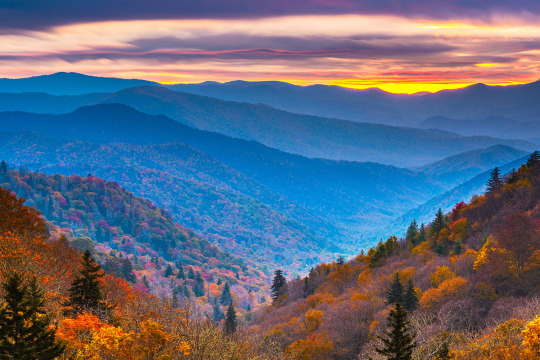
Grand Teton
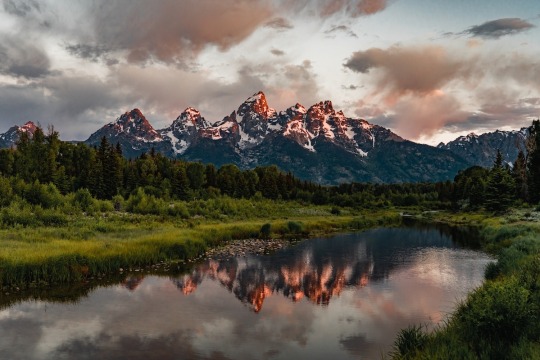
Yellowstone
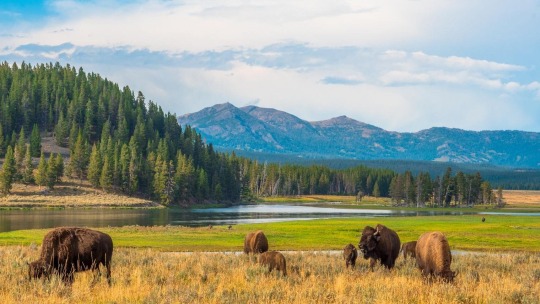
Acadia
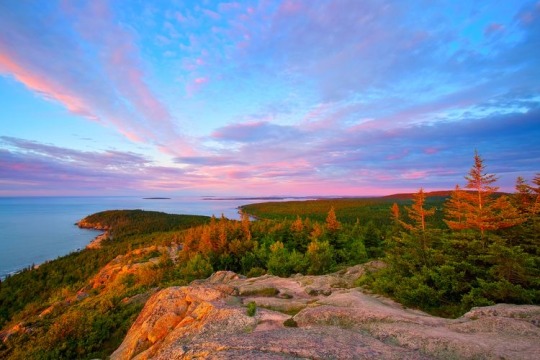
Olympic
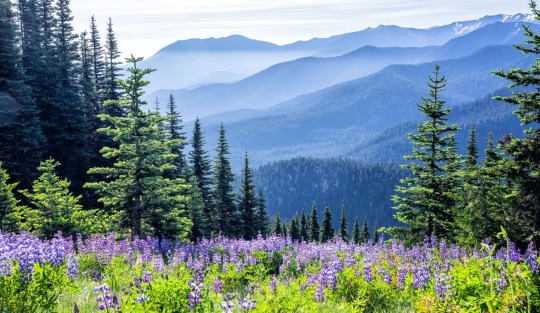

Mount Rainier
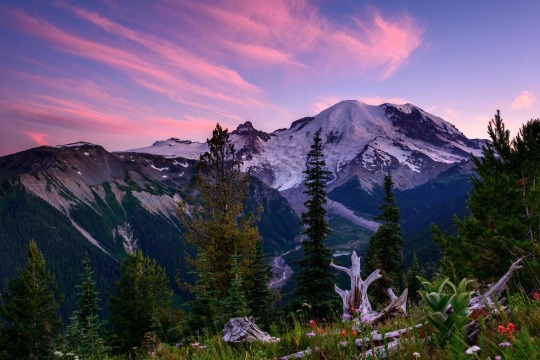
Yosemite
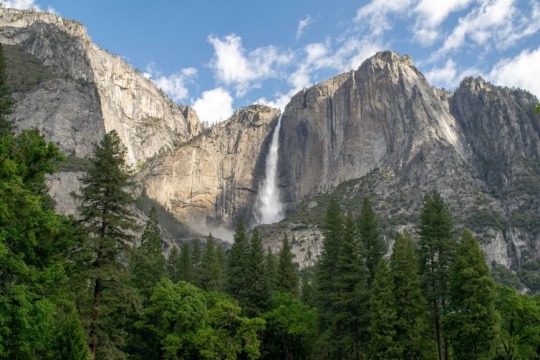

Grand Canyon
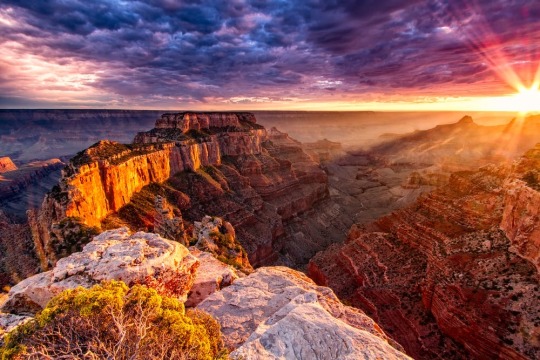
1K notes
·
View notes
Text

View from Buck Hill. Theodore Roosevelt National Park, South Unit.
Explore this wonderful park:
#travel#landscape#nature#nature photography#wanderlust#explore#original photography#photography#wandering#photographers on tumblr#north dakota#national park#findyourpark#Theodore Roosevelt national park#badlands#lensblr#national park service#wanderingjana
8 notes
·
View notes
Text
How to see Where Roosevelt Hunted and Ranched -- Long Loop Itinerary
Lemme tell ya about one of my favorite day trips from Watford City I call it the Long Loop. It wraps around T Roosevelt’s ranch and hunting area. Scan the itinerary. Then, go ahead and print out or save this map: TR Ranched Here Theodore Roosevelt cut a wide swath in life and in the Badlands. Historic significance This Long Loop covers the ground where TR ranched and hunted. The western side…

View On WordPress
#badlands in Montana#driving across Little Missouri National Grasslands#Little Missouri National Grasslands#north unit Theodore Roosevelt national park#road trip badlands#road trip north dakota#road trip planner#Theodore Roosevelt Accomplishment#Theodore Roosevelt Interesting Facts#Theodore Roosevelt National Park#Theodore Roosevelt National Park south unit
0 notes
Photo

And they say there’s nothing to see or do in North Dakota...pssht!
Photo: Theodore Roosevelt National Park, North Dakota
#north dakota#nd#theodore roosevelt national park#midwest#the west#western usa#the wild west#great plains#south unit#fall#autumn#fall colors#fall leaves#fall foliage#autumn colors#autumn leaves#autumn foliage#america#usa#the peace garden state#american road trip#road trip#vacation#tourism#travel#adventure#explore#off the beaten path#hiking#outdoors
12 notes
·
View notes